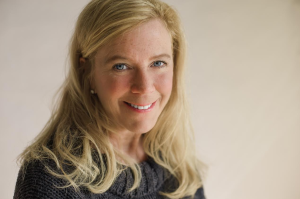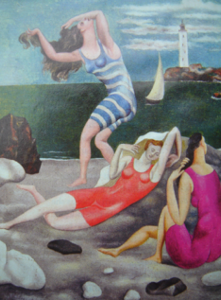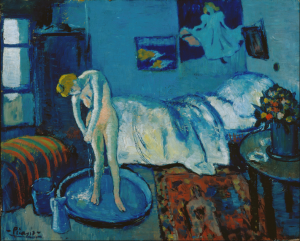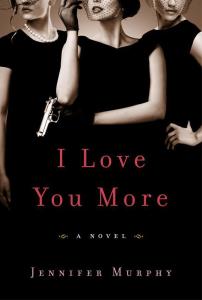Such is the case with Jennifer Murphy, a very gifted writer from Seattle, whom I first met at the Tin House Summer Writers Workshop—where I’ve now gotten to rendezvous with her several times—and at AWP and the Bread Loaf Writers’ Conference. As luck would have it, we never managed to be in any of the same workshops, though we enjoyed hanging. So it was with great pleasure over the summer of 2014 when both of our first books came out we decided to read together in Seattle. And then I got to read her first book, I Love You More. And I loved it!
Jennifer Murphy earned her Master of Fine Arts in Creative Writing from the University of Washington in 2014. She is the recipient of the 2013 Loren D. Milliman Scholarship and was a general contributor at the Bread Loaf Writers’ Conference from 2008 through 2012, Tin House in 2008 and 2010, and Wildacres in 2007 and 2009. She has lived and studied in North Carolina, Colorado, and Michigan. As the president of Citi Arts, Public Art and Urban Planning Consultants, she has created public art and design master plans for cities, airports, and rail projects nationally. She holds a BFA, MA, and MFA in visual art. In addition to her professors at UW – Maya Sonenberg, Shawn Wong, David Bosworth and David Shields – she has studied with Ann Hood, Jane Hamilton, Anne LeClaire, Helena Maria Viramontes, Helen Schulman, Lynn Freed, Ron Rash, Stacey D’Erasmo, Karen Shepard, Whitney Otto, and Ursula Hegi, among others. Her debut novel, I Love You More was released by Random House/Doubleday on June 14, 2014.
Bonnie ZoBell: One of the things I like best about I Love You More is how you handle the point-of-view. First of all, I have a particularly low tolerance for cutesy young narrators, but Picasso, only in elementary school, never even gets close to the too-cute factor and is in fact outspoken and funny. She can see things the adult can’t because she’s often in the background and not being noticed, or she’s hiding. But then you also have adult narrators—a rotating POV—so we can see exactly what they do and think. So fun getting the story from different perspectives. Did you always know you were going to handle the point of view this way, or did it happen as the book came together?
Jennifer Murphy: First, Bonnie, thanks so much for saying  that about Picasso. That was my intention, and it’s good to know you felt this way. And, yes, I always intended to write the novel in varying perspectives, but I wasn’t exactly sure whose. I began with that first chapter of Picasso, and when I got to the end where she is working on the sandcastle, it just naturally blended into the next voice being that of the detective. I admit I was reticent to write from a detective’s POV because I didn’t want readers to think I was necessarily writing a who done it, that the basis of the story was this idea of lies, but as soon as I began writing from Detective Kennedy’s POV, I liked him so much that I decided to go with it. I really enjoy reading books written from more than one POV. They feel more visual to me, and layered.
that about Picasso. That was my intention, and it’s good to know you felt this way. And, yes, I always intended to write the novel in varying perspectives, but I wasn’t exactly sure whose. I began with that first chapter of Picasso, and when I got to the end where she is working on the sandcastle, it just naturally blended into the next voice being that of the detective. I admit I was reticent to write from a detective’s POV because I didn’t want readers to think I was necessarily writing a who done it, that the basis of the story was this idea of lies, but as soon as I began writing from Detective Kennedy’s POV, I liked him so much that I decided to go with it. I really enjoy reading books written from more than one POV. They feel more visual to me, and layered.
BZ: Picasso loves her father despite the way he betrays her mother, herself, and his other wives. You hear this about father’s that do the worst things. As Picasso grows older (after the book is over), do you think she’ll have a harder time reconciling what happened to him?
JM: Very interesting question, and again I am so happy you are asking this. Yes, I do. How could she not? Someone she loved dearly has betrayed her. I see her going through many stages of grief and questioning as she ages. She will grapple the most with trust, and fear romantic relationships. I already know her entire arc. I knew it before I wrote the book. Even though the reader only sees this three-year time frame of her life, to my mind I needed to understand her entire journey to make this stage realistic.
BZ: You do a good job making all the wives both flawed and attractive in different ways, yet Diana always comes across as the most intelligent and sensual and beautiful. Do you think this is because Picasso, her daughter, does so much of the narration, or is she really the prize?
JM: I saw Diana as a kind of beautiful dream. She is an ideal. So yes, I suppose you could call her a prize, but one that is unaware of her beauty and power. She is the quintessential southern belle, strong, beautiful, smart, but she is also an artist so she is fraught with all those insecurities we artists have.
BZ: And to add further to the previous question, why do you think a man like Oliver would go on and marry other women after first marrying a woman like Diana? I guess it probably has nothing to do with how wonderful Diana is, right? What kind of a man would do this?
 JM: Oliver has his own insecurities, and he just isn’t, well, right. He is all about power. Women are a game to him. That, by the way, is why I decided to write them in first person plural – because Oliver doesn’t really differentiate them. To him, each of them is just another woman. Everyone, even his children, is one-dimensional to him. He only sees them as extensions of himself, not real human beings with feelings and needs of their own. Paper dolls would be an apt comparison. Oliver is a sociopath and sociopaths do not have empathy. You might say Diana is his arm piece, but beyond that his attraction to these women has little to do with their looks. It’s about the hunt and his ability to control them. If you look at these three women, each has insecurities where relationships are concerned, and yet each of them has a stubbornness that Oliver finds challenging. His goal is to bend them, but he doesn’t want it to break them. Where’s the challenge in that?
JM: Oliver has his own insecurities, and he just isn’t, well, right. He is all about power. Women are a game to him. That, by the way, is why I decided to write them in first person plural – because Oliver doesn’t really differentiate them. To him, each of them is just another woman. Everyone, even his children, is one-dimensional to him. He only sees them as extensions of himself, not real human beings with feelings and needs of their own. Paper dolls would be an apt comparison. Oliver is a sociopath and sociopaths do not have empathy. You might say Diana is his arm piece, but beyond that his attraction to these women has little to do with their looks. It’s about the hunt and his ability to control them. If you look at these three women, each has insecurities where relationships are concerned, and yet each of them has a stubbornness that Oliver finds challenging. His goal is to bend them, but he doesn’t want it to break them. Where’s the challenge in that?
BZ: Perhaps it’s the romantic in all of us, or at least me, that wants Diana and Kyle to hook up not far into the book. Of course, he’s the main detective in the murder case, so he’s a little worrisome, too. Why do you think Diana and Picasso aren’t more concerned about him?
JM: Ha! I’m a romantic too. I think they are leery of him at first, but as they get to know him he fulfills a void in each of their characters. Diana has spent twelve years with a man who doesn’t really see her. She doesn’t know this until she meets a man who does. Kyle is also not charming or slippery like Oliver. He is an everyman. He’s a bit heavy around the middle. His nose was broken. He has foibles and insecurities, and he’s lonely – though he isn’t aware of this until he meets Diana. Most importantly, Kyle is safe. Both Diana and Picasso have spent years with a man who wasn’t safe or reliable. They had to work for his love.
BZ: The three wives’ rendezvous are spectacular. They swim in the nude and then nap in the sun together. Where did you get that idea? What do you think it says about their relationship?
JM: The idea actually came from a Pablo Picasso painting – Women Bathing, 1918. Picasso painted several scenes of women bathing, some nude, some not. When I first wrote the novel, I was concerned it may not be believable, but then I began thinking – what if it were me? Would I do this? And I thought, yes, I would. There is a thread that ties these three women together, and that thread ultimately grows into something much more. They see themselves in each other, so the swimming and napping was a way for me to show that. I also wanted The Wives sections to have this kind of ethereal, perhaps even religious, feeling. By having them undress together and swim together and nap together they became a sort of holy trinity, and the water was a kind of baptism. This also plays out in the rose petal baths. Water becomes the metaphor for their rebirth. Bathing women was a recurring theme in many impressionist and post impressionist era paintings.
BZ: I love what your website says about your holding MFAs in creative writing and painting. You’re multi-talented! You say:
I was interested in how both writers and painters are storytellers, and how storytellers are in essence liars, but without the negative stigma. Pablo Picasso said, “Art is a lie that makes us realize truth.”
I wanted to explore this relationship between lying and truth, and what better way to do that than to create a cast of characters who through circumstance would find themselves grappling with lies? I also wanted to see how Pablo Picasso’s theory played out in the art of life. Are all lies bad? Is lying to save someone we love more acceptable, even altruistic?
What do you think Pablo Picasso would have thought about the characters’ lies in your book?
JM: Ha! I kept seeing his paintings of women in baths  when I wrote the novel. I already mentioned Women Bathing, but there is also Woman Leaving The Bath, 1901, and The Blue Room, among others. BTW – on the release day of I Love You More, June 17, 2014, a hidden painting was found beneath the brushstrokes of The Blue Room, and being who I am I took that to be a good sign. I actually visualized Women Bathing on the book’s cover the entire time I was writing the novel, but that didn’t happen. In terms of the characters’ lies, I’d like to believe that Picasso would find their lies altruistic. But I think it’s mine I am most worried about. As the novel’s writer, I am the real liar here. Would he think that through my lies a greater truth emerged?
when I wrote the novel. I already mentioned Women Bathing, but there is also Woman Leaving The Bath, 1901, and The Blue Room, among others. BTW – on the release day of I Love You More, June 17, 2014, a hidden painting was found beneath the brushstrokes of The Blue Room, and being who I am I took that to be a good sign. I actually visualized Women Bathing on the book’s cover the entire time I was writing the novel, but that didn’t happen. In terms of the characters’ lies, I’d like to believe that Picasso would find their lies altruistic. But I think it’s mine I am most worried about. As the novel’s writer, I am the real liar here. Would he think that through my lies a greater truth emerged?
BZ: Do you have a favorite writing conference? And if so, why is it your favorite?
JM: Oh that is such a hard question! What I like about Tin House is its west coast laid backness, and it is civilized. Cell phones actually work there (Reed College campus). That said, what I like about Bread Loaf is that cell phones don’t work. There is also something so singular about the Bread Loaf experience. Being isolated up in the mountains, those yellow cottages, the Adirondack chairs. Bread Loaf is as much a visual experience as a mental one, and for me there is also the history of all those great writers that came before. When I’m there I feel as if I am part of something so much bigger than me, and that challenges me to try to be worthy. Though I know a lot people don’t, I write a lot at Bread Loaf. I always ask Noreen for a room with a writing table.
But I also need to say that my memories of any conference I’ve attended are directly tied to the workshop leader I had. Ann Hood was my first workshop leader at a conference in the North Carolina Blue Ridge Mountains called Wildacres. Ann is an amazing teacher. I feel so lucky to have had her first. As I write, I always hear her in the back of my mind saying things like “too many he noddeds” or “you used the same word ten times on this page” or “there needs to be more tension here.” I also learned so much from Helena Viramontes at Bread Loaf one year, especially about story and pacing, and how spiritualism and magic can inform story. And Stacey d’Erasmo, also at Bread Loaf, told me to drop a character from the novel I was working on at the time, which was hard for me to hear but ended up being right on. The toughest experience I had at Bread Loaf was with Lynn Freed. I’ll never forget when she told me “its not on the page,” referring to my story. I was devastated (I actually cried later) because isn’t that the basis for any story or novel, that it needs to be solidly on the page? And if I couldn’t write well enough for my story to be grounded on the page, then was I fooling myself even thinking I could be a writer? Probably that was the harshest and yet most beneficial criticism I’ve ever received. Every teacher I’ve had – both at conferences and in my MFA program – has had an impact on my writing, usually in very unexpected ways.
BZ: What are you working on now?
JM: A novel. The current title is Fugitive Pigment. It’s about an artist who has disappeared (sixteen years earlier), and the question is did she run and is she in hiding somewhere or is she dead? The main protagonist is her daughter, who was three when her mother disappeared, and is now a senior in college. And yes, there is more than one POV. The subplot has to deal with this idea of running, not confronting. The title Fugitive Pigment refers to what the critics have coined the artist’s painting style: layers and layers of fugitive (running) pigment. The painter is her paintings. The paintings are the artist. Where is the point of separation between the two, or is there one? Whereas I LOVE MORE referenced the work of the artist Picasso, in this book I will reference Henri Matisse and the Fauvism movement. I’m loving how through this character I am able to live inside a painting again. It’s been awhile since I stretched a canvas or mixed paint or smelled turpentine or felt a brushstroke. I think I may just have to do that over the holidays.
Bonnie, thanks so much for doing this and for such intriguing questions.
I appreciate your coming by, Jennifer!


Leave A Comment